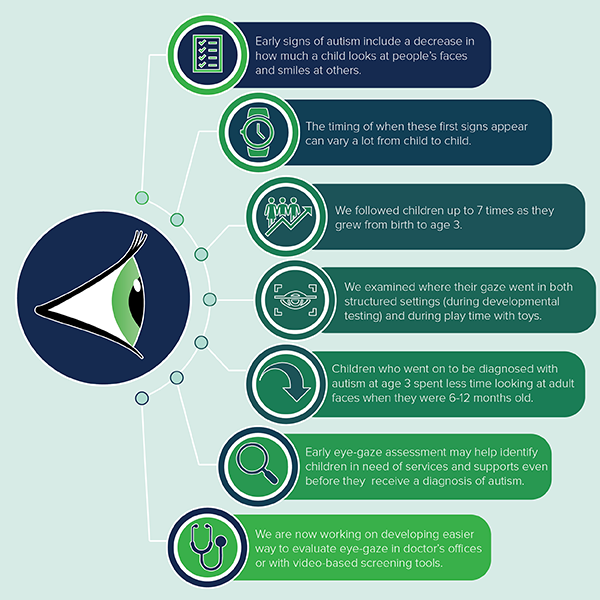
DECLINE IN LOOKING AT FACES MAY SIGNAL ONSET OF AUTISM IN INFANTS
By Devon Gangi, Assistant Project Scientist, Department of Psychiatry and Behavioral Sciences
07/27/2022

|
The first signs of autism usually appear in the first two years of life, but exactly when they occur can vary quite a bit from child to child. Our lab has followed infants from shortly after birth until age 3, through the window when autism characteristics develop. We see the children multiple times so that we can directly measure the timing of onset. Past studies that have similarly followed babies over the first few years of life have found that children who developed autism showed declines in social-communication behavior, such as looking at the faces of other people or smiling at others, between 6 and 36 months.
In 2010, the Ozonoff lab reported that infants who were diagnosed with autism at age 3 showed a decline in how often they directed their gaze toward an adult who was interacting with them as early as 12 months of age. However, that study was conducted in a relatively small group of children, so it was important to replicate these findings to make sure that they are accurate. In a new paper, we followed two independent groups of infants from 6 to 36 months (155 children in one group and 126 in the other) and examined their gaze behavior in different settings and contexts. This included interacting with an adult, either during developmental testing or during play with toys. We found the same results as the original study. Across both groups of children—and both settings—most children who were diagnosed with autism at 36 months showed sharp decreases in how often they looked at the faces of the adult they were interacting with relative to children without autism, including those with other developmental conditions, such as language delays. Children with autism showed lower levels of gaze to the adult’s face by 6-12 months of age than children who did not develop autism.
These findings add to our understanding of typical and atypical trajectories of social-communicative behaviors and the early development of autism characteristics, suggesting that declining developmental trajectories in some social-communicative behaviors across infancy may occur in most children diagnosed with autism by age 3. Key social behaviors, like looking at or smiling toward other people, could be tracked at every well-child visit and charted, much like doctors do for height and weight, to be sure that a child’s social development is on track and does not show declines. Such methods might allow children to be identified during the decline of skills and participate in helpful early intervention, even before meeting criteria for a full diagnosis of autism. This study used a time-intensive, laboratory-based method to examine social-communicative behaviors, and our lab is currently working on methods of evaluating these behaviors that could be applied outside the laboratory, such as in a doctor’s office, through a video-based screening tool.
